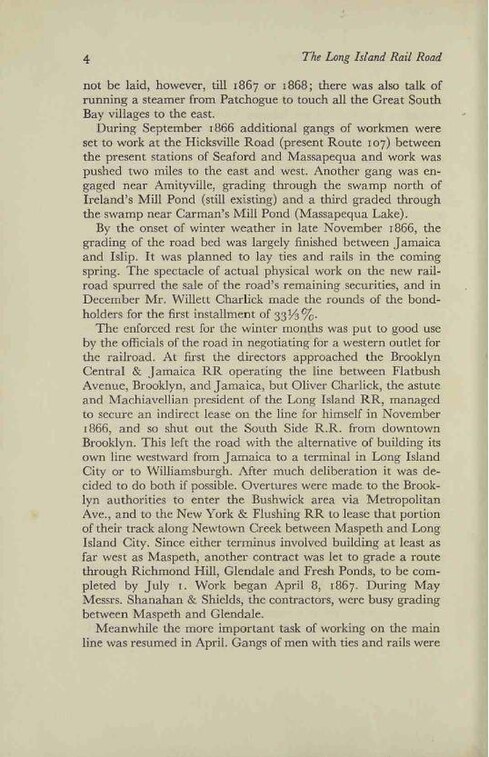not be laid, however, till 1867 or 1868; there was also talk of running a steamer from Patchogue to touch all the Great South Bay villages to the east.
During September 1866 additional gangs of workmen were set to work at the Hicksville Road (present Route 107) between the present stations of Seaford and Massapequa and work was pushed two miles to the east and west. Another gang was engaged near Amityville, grading through the swamp north of Ireland's Mill Pond (still existing) and a third graded through the swamp near Carman's Mill Pond (Massapequa Lake).
By the onset of winter weather in late November 1866, the grading of the road bed was largely finished between Jamaica and Islip. It was planned to lay ties and rails in the coming spring. The spectacle of actual physical work on the new railroad spurred the sale of the road's remaining securities, and in December Mr. Willett Charlick made the rounds of the bondholders for the first installment of 33⅓%.
The enforced rest for the winter months was put to good use by the officials of the road in negotiating for a western outlet for the railroad. At first the directors approached the Brooklyn Central & Jamaica RR operating the line between Flatbush Avenue, Brooklyn, and Jamaica, but Oliver Charlick, the astute and Machiavellian president of the Long Island RR, managed to secure an indirect lease on the line for himself in November 1866, and so shut out the South Side R.R. from downtown Brooklyn. This left the road with the alternative of building its own line westward from Jamaica to a terminal in Long Island City or to Williamsburgh. After much deliberation it was decided to do both if possible. Overtures were made to the Brooklyn authorities to enter the Bushwick area via Metropolitan Aye., and to the New York & Flushing RR to lease that portion of their track along Newtown Creek between Maspeth and Long Island City. Since either terminus involved building at least as far west as Maspeth, another contract was let to grade a route through Richmond Hill, Glendale and Fresh Ponds, to be completed by July 1. Work began April 8, 1867. During May Messrs. Shanahan & Shields, the contractors, were busy grading between Maspeth and Glendale.
Meanwhile the more important task of working on the main line was resumed in April. Gangs of men with ties and rails were
